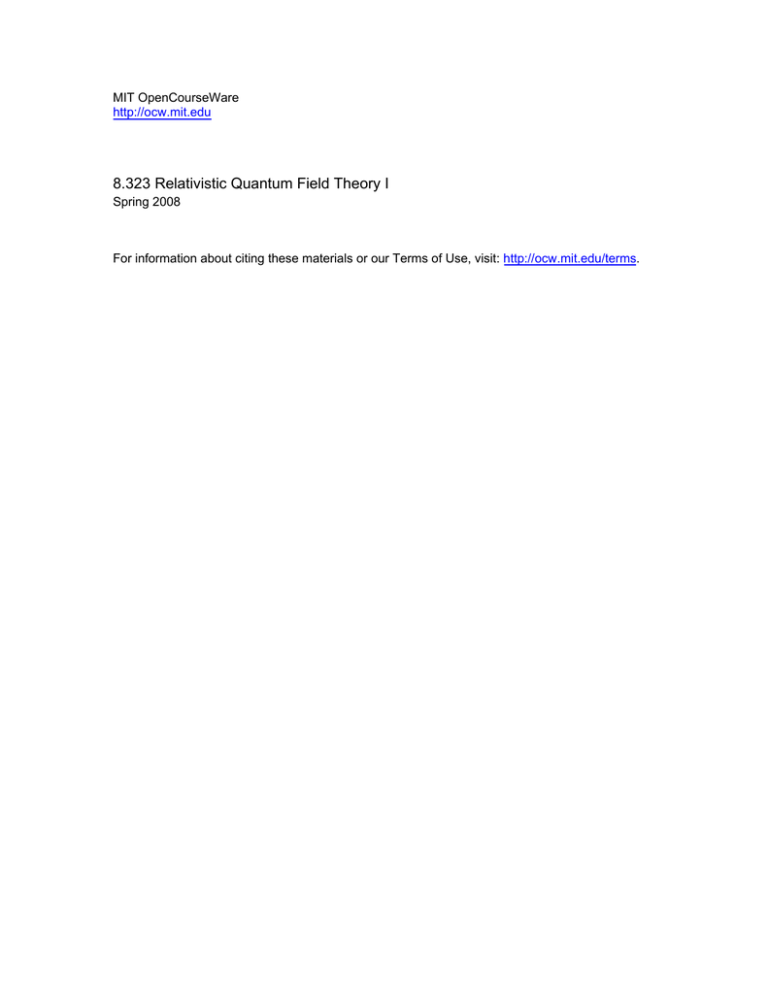Document 13650443
advertisement

MIT OpenCourseWare http://ocw.mit.edu 8.323 Relativistic Quantum Field Theory I Spring 2008 For information about citing these materials or our Terms of Use, visit: http://ocw.mit.edu/terms. MASSACHUSETTS INSTITUTE OF TECHNOLOGY Physics Department 8.323: Relativistic Quantum Field Theory I Prof. Alan Guth February 10, 2008 PROBLEM SET 1 Corrected Version† REFERENCES: Peskin and Schroeder, Sections 2.1 and 2.2. Problem 1: The energy-momentum tensor for source-free electrodynamics (10 points) Peskin and Schroeder, problem 2.1. (Note that when you are asked to “derive Maxwell’s equations as the Euler-Lagrange equations of this action,” you should be aware that only two of Maxwell’s four equations are obtained in this way. You should show that the remaining two Maxwell equations follow directly from the definition of Fµν in terms of the vector potential Aµ (x).) Besides parts (a) and (b) as stated in the textbook, please answer the following additional part: (c) Consider the transformation Aµ (x) → Aµ (x) = Aµ (x) + aν Fν µ (x) . Show that this transformation is equivalent to a translation in in x, as in part (b), combined with a gauge transformation. Show that when Noether’s theorem is applied to this symmetry, it gives directly the symmetric form of the energy-momentum tensor. † This version replaces the February 7 version, which had a typographical error in Problem 2. The second expression for the Lagrangian L was corrected by replacing � nπ 2 �2 � by nπ a �2 . 8.323 PROBLEM SET 1, SPRING 2008 p. 2 Problem 2: Waves on a string (10 points)* A string of length a, mass per unit length σ and under tension T is fixed at each end. The Lagrangian governing the time evolution of the transverse displacement y(x, t) is � �2 � � a � � �2 σ ∂y T ∂y L= dx − , 2 ∂t 2 ∂x 0 where x identifies position along the string from one end point. By expressing the dis­ placement as a sine series Fourier expansion in the form � ∞ � nπx � 2� qn (t) , sin y(x, t) = a n=1 a show that the Lagrangian becomes L= ∞ � � σ n=1 2 q̇n2 � T � nπ �2 2 − qn . 2 a Derive the equations of motion. Hence show that the string is equivalent to an infinite set of decoupled harmonic oscillators with frequencies � � � T nπ ωn = . σ a Problem 3: Fields with SO(3) symmetry (10 points) † Verify that the Lagrangian density � = 21 ∂µ φa ∂ µ φa − 21 m2 φa φa for a triplet of real fields φa (a = 1, 2, 3) is invariant under an infinitesimal SO(3) rotation by δθ, φa → φa = φa + δθ abc nb φc , where na is a unit vector and abc is the fully antisymmetric Livi-Civita symbol, with 123 = 1. Compute the Noether current j µ . Deduce that the three quantities � Qa = d3 x abc φ̇b φc are all conserved and verify this directly using the field equations satisfied by φa . * Problem taken from David Tong’s Lectures on Quantum Field Theory, http://www.damtp.cam.ac.uk/user/dt281/qft.html. † Problem taken from David Tong’s Lectures on Quantum Field Theory, http://www.damtp.cam.ac.uk/user/dt281/qft.html, with minor changes in notation. 8.323 PROBLEM SET 1, SPRING 2008 p. 3 Problem 4: Lorentz transformations and Noether’s theorem for scalar fields (15 points) Infinitesimal Lorentz transformations, including both rotations and boosts, can be described by xλ = xλ − Σλ σ xσ , where Σλσ = −Σσλ and Σλ σ ≡ η λκ Σκσ . (a) Show that to first order in Σ, x2 ≡ xλ xλ = xλ xλ . That is, show that the length of a vector is invariant under this transformation. Now consider a scalar field φ(x), with Lagrangian � = 21 ∂µ φ ∂ µ φ − V (φ) , which transforms as φ (x ) = φ(x) . Expanding to lowest order, φ (x ) = φ(xλ + Σλ σ xσ ) = φ(xλ ) + Σλ σ xσ ∂λ φ(x ) . Dropping the primes on the coordinates, φ (x) = φ(x) + Σλσ xσ ∂ λ φ(x) . (b) Show that the conserved Noether current for this transformation can be written as j µλσ = xλ T µσ − xσ T µλ , where ∂µ j µλσ = 0 , where T µν = ∂ µ φ ∂ ν φ − η µν � is the conserved energy-momentum tensor which we have already derived. You should apply Noether’s theorem, and then verify from the equations of motion that your expression for the current is actually conserved. (c) When λ and σ are spacelike, the conserved quantity is the angular momentum (e.g., j 012 = jz , the density of angular momentum in the z direction). What is the signif­ icance of the conserved quantity when λ = 0, σ = i?

